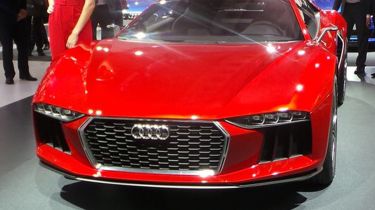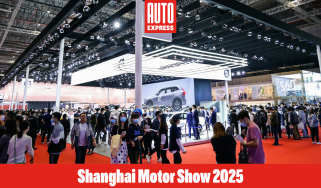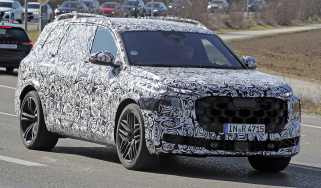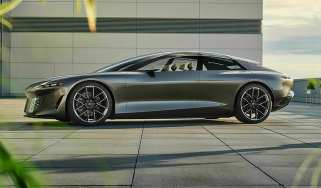Audi Nanuk concept revealed
Audi Nanuk concept previews new design language and SUV technology
This is the Audi Nanuk concept, which has been revealed on the eve of the Frankfurt Motor Show. Audi describes it as a crossover concept that ‘combines the dynamics of a high-performance sports car with Audi's quattro expertise on the road, on the race track and also off-road,’ and it could point the way towards a production car that creates more volume for Audi in the mid-engined segment.
It’s powered by a mid-mounted 5.0-litre V10 TDI diesel engine that develops 537bhp and 1,000Nm of torque from just 1,500rpm. The twin-turbocharged V10 is connected to a seven-speed S tronic gearbox and power is delivered to all four wheels via a specially designed quattro drivetrain.
According to Dr Ulrich Hackenberg, Audi's new R&D chief, the engine is all-new and part of a new six, eight and ten-cylinder modular diesel engine family. Does it mean that the next R8 could use diesel power, as originally suggested by the 2008 R8 V12 TDI concept? "If we put such an engine into production, we will need to use it for a wide variety of applications," Hackenberg replied.
An overwhelmingly positive reaction to the Giegiaro Parcour concept, shown at Geneva earlier this year, persuaded Audi to translate the supercar SUV crossover into a concept that was closer to reality. If reaction is sufficiently positive then it's something that's genuinely being considered for production as part of the next-generation R8 family, using the R8's lightweight, multi-material chassis.
Despite Audi's claim the Nanuk concept weighs roughly 1,900kg, the sprint from 0-62mph takes just 3.8 seconds and the top speed is 190mph. However, Audi also claims that the car could return 36.2mpg.
The concept has a wheelbase of 2,710mm. It is 4,541 mm long, 1,990mm wide and 1,337mm tall. That gives it pretty unique dimensions – shorter than an Audi Q5, wider than a Q7 and just 85mm taller than an R8. The Nanuk’s body is built from aluminium, while anything painted red on the exterior is made from carbon fibre-reinforced polymer (CFRP). The car rides on 22-inch alloys which cover carbon-ceramic brake discs.
The firm claims the concept “opens a new chapter in the Audi design language,” with some design themes set to feature on its next SUVs, and the next-generation R8. A hexagonal single-frame grille that’s much flatter than on the firm’s current large cars dominates the car’s nose. Like the facelifted Audi A8, the concept features Audi Matrix LED headlights, which sit above front air vents that have been pushed out wide in the front bumper.
At the side, the doors swing upward instead of outward, while the door mirrors have been switched for rear-view cameras. The car also has sideblades, like an R8’s but smaller, that cover the main air intake for the engine. A second, smaller blade behind the side window is moveable and facilitates the flow of air through the engine compartment.
At the rear, a large rear window covers the TDI engine, while the entire rear bodywork can be flipped upward in one piece. The boot is in the front, and can accommodate a golf bag.
Inside, the minimalist interior includes a configurable instrument cluster that allows the driver to pull-up displays and information as required, and an induction charger for mobile phones. Screens for the door mirror cameras sit in the A-pillars, while the rear-view mirror is also a TFT screen, just like Audi’s Le Mans car.
Tech features include a new generation of air suspension with electronically controlled dampers. The driver can raise or lower the ground clearance in three stages, or allow the car to adjust itself based on driving speed and sat-nav data.
The concept also features four-wheel steering. At low speeds, the rear wheels turn up to nine degrees in the opposite direction of the front wheels. This reduces the turning circle to roughly 10 metres. At higher speeds the system turns the rear wheels by as much as 2.5 degrees in the same direction as the front wheels to increase stability.
Find a car with the experts







